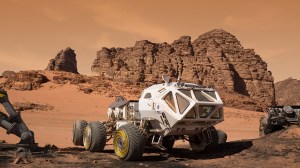Drs. Jia and Anyszka

Exploration and colonization of Mars ignite the imagination of people around the world. Many successful missions have been launched to the red planet. Each time we manage to transport bigger and more complex machines. The materials that we use on Earth have been adopted for the missions to explore Mars. To continue the advances, we must develop materials tailormade to withstand Martian conditions.
Metal and ceramics can resist radiations and low temperatures on Mars, in contrast to polymeric materials, like rubber. That’s why Mars rovers currently use aluminum wheels instead of rubber tires widely used on Earth. However, there is a good reason for using rubber to produce tires – its elastic properties, which provide good grip to the road, resist impact damages, and reduce vibration, assuring safety and reliability. Modern rubber tires can support a 400 tons mining truck or an F1 bolide traveling with a speed of 500 km/h. In comparison, the Curiosity rover weights 900 kg, travels with a maximum speed of 180 m/h, and its wheels show significant damages likely due to mechanical impact of rough surfaces after the mission (Fig. 1).
When we think about the future heavy-duty rovers, which would transport the cargo and crew, it’s hard to imagine not using rubber tires.
The aim of this project is to design tailor-made rubber compounds that withstand Martian conditions by using low glass-temperature rubbers – butadiene rubber or a unique butadiene/silicone rubber blend to provide still good elasticity at the low temperatures experienced on Mars.

Current Project
In this project, you will gain experience with…
- Interdisciplinary work, combining chemical synthesis, rubber technology, and space engineering
- Chemical modification of rubber molecules
- Designing rubber formulations
- Mars environment
- Hands-on work in chemical and rubber laboratories
